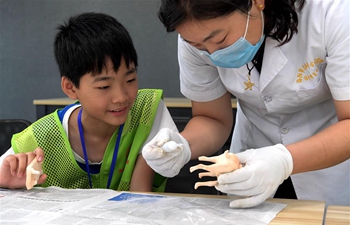by Tan Jingjing
LOS ANGELES, Aug. 2 (Xinhua) -- A ground-breaking electronic chip developed by Chinese scientists has recently attracted great interest of U.S. media and tech circle.
Chinese scientists incorporated the chip into a riderless autonomous bicycle, which can detect and track targets, avoid obstacles, self-balance, understand voice commands and even make independent decisions as a result of the chip's simultaneous processing of versatile algorithms and models.
"This wobbly self-driving bicycle is a symbol of growing Chinese expertise in advanced chip design," said MIT Technology Review in an article.
The Tianjic chip features a hybrid design that seeks to bring together two different architectural approaches to computing: a conventional, von Neumann design and a neurologically inspired one, said the article.
"The two architectures are used in cooperation to run artificial neural networks for obstacle detection, motor and balance control, and voice recognition, as well as conventional software," according to the article.
The chip also hints at the progress China is making in developing its own chip design capabilities, said the MIT Technology Review piece.
The research achievement, conducted by Shi Luping and his colleagues at the Center for Brain Inspired Computing Research of Tsinghua University, was published as the cover story of Nature magazine on Thursday.
"It's not the first self-driving bike. But equipped with an AI chip, it may be the nearest to thinking for itself," said an article published on The New York Times, titled "And Now, a Bicycle Built for None."
As corporate giants like Ford, GM and Waymo struggle to get their self-driving cars on the road, a team of researchers in China are rethinking autonomous transportation using a souped-up bicycle, said the article.
"In handling all these skills with a neuromorphic processor, the project highlighted the wider effort to achieve new levels of artificial intelligence with novel kinds of chips," said the article.
The hope is that such chips will eventually allow machines to navigate the world with an autonomy not possible today, said The New York Times.
Eric Topol, a scientist at the renowned Scripps Institute in California, tweeted that "It's a big AI day with the Tianjic chip, autonomous bicycle and the implications for this hybrid/synergic brain-like and machine capability."
Shi's Tianjic chip can integrate the two approaches into one hybrid platform, which enables it to accommodate both machine-learning algorithms and brain-inspired circuits.
The first generation of the Tianjic chip was developed in 2015, followed by the second generation in 2017.
After continuous improvement, the current second-generation Tianjic chip features even higher performance with much lower power consumption.













